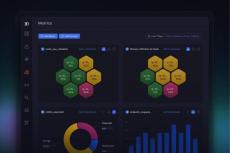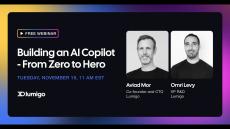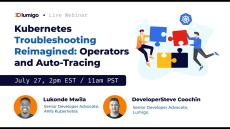|
By Orr Weinstein
AI is changing our world, and its impact on observability is no different. This article discusses some of the components of a good observability platform, how AI is well-positioned to revolutionize observability, and how Lumigo Copilot Beta will provide substantial value to customers and partners.
|
By Omri Levy
Artificial intelligence is reshaping industries at an unprecedented pace. AI has found its way into almost every vertical, from writing code to diagnosing illnesses, promising efficiency and innovation. The idea of an AI Copilot—a tool that acts as your assistant to tackle complex tasks—is particularly exciting. In our space, observability, the possibilities seemed endless. We asked ourselves how AI could simplify troubleshooting in microservices.
|
By Orr Weinstein
Generative AI (GenAI) is revolutionizing industries by driving innovation and delivering unparalleled customer value. Across sectors, its impact is evident.
|
By Erez Berkner
We’re excited to announce Lumigo Metrics, the latest addition to Lumigo’s industry-leading observability suite. Developers already rely on Lumigo for the most advanced distributed tracing on the market, coupled with powerful log management capabilities and the AI-driven insights of Lumigo Copilot Beta—empowering teams to troubleshoot faster and smarter. Now, we’re taking it a step further.
|
By Orr Weinstein
In September, Lumigo announced we were exploring how AI can help shape the next generation of observability. Since then, we’ve unveiled the beta of Lumigo Copilot, which we believe will be the most intelligent AI in observability. Today, we’re providing an update on our progress and inviting our customers to participate in the beta.
|
By Yan Cui
Lambda’s Event-Source Mapping (ESM) has been a game-changer for Lambda users. It gives users an easy and cost-efficient way to process events from Amazon SQS, Amazon Kinesis, Amazon DynamoDB, Amazon Managed Streaming for Apache Kafka (Amazon MSK), Amazon MQ and more. It handles all the complexities around polling, including scaling the no. of pollers. And there’s no charge for this invisible layer of infrastructure!
|
By Winston Bowden
Generative AI (GenAI) is still in its infancy, but its impact is already being felt across industries. Over the past year, production applications leveraging GenAI have gone from proof-of-concept to delivering real-world value. According to the World Economic Forum, 75% of surveyed companies plan to adopt AI technologies by 2027. Leading cloud providers like AWS are making significant investments.
|
By Winston Bowden
Predictive analytics has become a key goal in observability. If teams can foresee potential system failures, performance bottlenecks, or resource constraints before they happen, they can act preemptively to mitigate issues. AI holds the promise of making this possible. In this post, we explore how AI can push observability toward predictive analytics, the industry’s current hurdles, and practical use cases for leveraging AI today.
|
By Yan Cui
Serverless is an incredible paradigm, but performance tuning sometimes feels like a black box. You have no control over the infrastructure, but that doesn’t mean you can’t optimize. In this post, let’s look at five ways to take serverless performance to the next level.
|
By Winston Bowden
Observability is crucial for maintaining complex systems’ health and performance. In its traditional form, observability involves monitoring key metrics, logging events, and tracing requests to ensure that applications and infrastructure run smoothly. The emergence of Artificial Intelligence (AI) promises to revolutionize the way organizations approach observability.
|
By Lumigo
Make sure to subscribe so you don't miss out on any new livestreams and observability content! With one-click distributed tracing, Lumigo lets developers effortlessly find and fix issues in serverless and containerized environments.
|
By Lumigo
Learn how Lumigo created an ai Copilo from an idea into an expert AI-powered observability problem-solver. We'll discuss our early challenges and how we overcame them. Get an insider's look at the systematic improvements we applied, from guiding the model like a junior developer to setting up an evaluation pipeline that allowed us to monitor and scale effectively.
|
By Lumigo
Production downtime is one of the most frightening and expensive things that can happen to an organization. When it happens, developers need to sift through large amounts of data to find and resolve the issue, which can take time. What if you could significantly reduce that time?
|
By Lumigo
Learn how to achieve cost-effective observability without sacrificing coverage. Gain insights into configuring log management and distributed tracing tools to balance cost and performance, ensuring comprehensive coverage.
|
By Lumigo
Lumigo is an observability and troubleshooting platform that autonomously deploys Observability in under 5 minutes with a single click, automatically capturing and contextualizing all of the metrics, logs, and distributed traces developers need to troubleshoot microservice issues in production. Lumigo is the only observability platform that enriches traces with complete in-context request and response payloads and correlates them to the relevant logs and metrics, enabling developers to resolve issues up to 80% faster.
|
By Lumigo
Embark on an astral journey through 'The Spindlewhorl Enigma of Serverless Debugging' with our Debuggers Guide to the Galaxy livestream. Unravel cosmic code mysteries and venture where no debugger has gone before! By the light of the Guide and the glow of the trace, the stars and deployed apps shall reveal their secrets. To infinity, and beyond bugs! Make sure to subscribe so you don't miss out on any new livestreams and observability content!
|
By Lumigo
Grab your digital towel and embark on an intergalactic coding adventure with 'The Debuggers Guide to the Galaxy,' hosted by the serverless sage Yan Cui and the code-wielding DeveloperSteve. In a universe where devops are as perplexing as Vogon poetry and deployment seems guided by Infinite Improbability Drives, our hosts will guide you through the cosmic chaos. With introductions that defy normal spacetime and a #Dart container #debugging session that's almost, but not quite, entirely out of this world.
|
By Lumigo
Grab your digital towel and embark on an intergalactic coding adventure with 'The Debuggers Guide to the Galaxy,' hosted by the serverless sage Yan Cui and the code-wielding DeveloperSteve. In a universe where devops are as perplexing as Vogon poetry and deployment seems guided by Infinite Improbability Drives, our hosts will guide you through the cosmic chaos. With introductions that defy normal spacetime and a dart container debugging session (using dartfrog) that's almost, but not quite, entirely out of this world.
|
By Lumigo
Kubernetes operators help to simplify, streamline, and automate application tasks beyond the conventional Kubernetes offerings. In this webinar, AWS Developer Advocate for Kubernetes, Lukonde Mwila, will delve into the remarkable capabilities of Kubernetes operators and how to leverage them in your applications. You’ll also learn how Lumigo built a Kubernetes operator for seamless distributed tracing leveraging OpenTelemetry. We will also demonstrate how our operator transforms complex processes into a single command, promising an unmatched user experience and exceptional app health insights.
|
By Lumigo
Using Lumigo's end-to-end distributed tracing that surfaces critical payload data, Zesty is able to find the root cause of errors in their microservice-based apps without using logs. Make sure to subscribe so you don't miss out on any new livestreams and observability content! With one-click distributed tracing, Lumigo lets developers effortlessly find and fix issues in serverless and containerized environments.
- December 2024 (4)
- November 2024 (5)
- October 2024 (4)
- September 2024 (3)
- August 2024 (2)
- July 2024 (1)
- June 2024 (1)
- April 2024 (1)
- March 2024 (7)
- February 2024 (7)
- January 2024 (2)
- December 2023 (6)
- November 2023 (8)
- October 2023 (5)
- September 2023 (7)
- August 2023 (13)
- July 2023 (7)
- June 2023 (5)
- May 2023 (5)
- April 2023 (9)
- March 2023 (4)
- February 2023 (2)
- January 2023 (4)
- December 2022 (5)
- November 2022 (6)
- October 2022 (5)
- September 2022 (5)
- August 2022 (10)
- July 2022 (10)
- June 2022 (5)
- May 2022 (2)
- April 2022 (2)
- March 2022 (9)
- December 2021 (1)
- November 2021 (4)
- October 2021 (3)
- September 2021 (3)
- August 2021 (2)
- July 2021 (3)
- June 2021 (3)
- May 2021 (5)
- April 2021 (2)
- March 2021 (3)
- February 2021 (4)
- January 2021 (3)
- December 2020 (6)
- November 2020 (6)
- October 2020 (1)
- September 2020 (2)
- August 2020 (2)
- July 2020 (3)
- June 2020 (5)
- May 2020 (6)
- April 2020 (1)
- March 2020 (6)
- February 2020 (3)
- January 2020 (9)
- December 2019 (2)
- November 2019 (2)
- October 2019 (6)
- September 2019 (6)
- August 2019 (3)
- July 2019 (7)
- June 2019 (7)
- May 2019 (6)
- April 2019 (5)
- March 2019 (6)
- August 2018 (1)
Lumigo is a SaaS platform for monitoring and debugging AWS serverless applications.
Quickly identify performance optimizations and resolve critical issues in your distributed environment using smart monitoring, alerting, and end-to-end automated tracing.
Key Features:
- Monitoring - Understand exactly what's happening in your application with performance and cost metrics for Lambda functions and managed services, alongside auto-generated architecture mapping.
- Alerting - Leverage curated best practices to get automatic-guidance for your serverless configuration and deployment activities.
- Debugging & Troubleshooting - Identify root cause of issues in your distributed environment at speed with correlated logs, end-to-end transaction maps and a virtual stack trace.
Founded in 2018, Lumigo is an AWS Advanced Technology Partner and holds AWS DevOps Competency status.
Lumigo supports all major runtimes, and with no code changes required you can get up and running in minutes. Gain the visibility you need to run serverless with confidence! Get started today with a 30-day free trial.





















